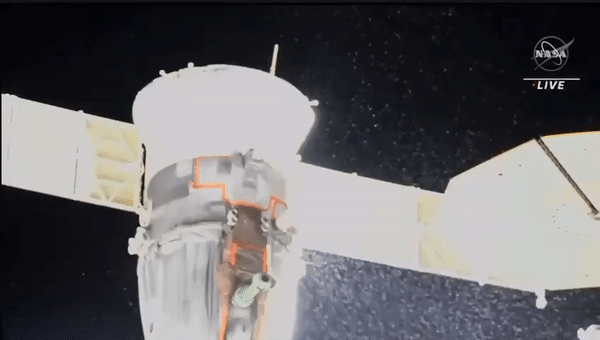
[ad_1]
The leaky Russian Soyuz spacecraft docked to the International Space Station (ISS) has a small hole in it, an inspection has found.
The Soyuz’s coolant leaked away on Wednesday night (Dec. 14), as two cosmonauts were getting ready to perform a spacewalk outside the orbiting lab (which was soon canceled). In the days since, Russia’s space agency Roscosmos has been trying to nail down the cause and consequences of the leak, with some help from its ISS partners.
That help includes an inspection of the suspected leak area on the Soyuz using cameras mounted on the station’s huge Canadarm2 robotic arm. That survey, which wrapped up on Sunday (Dec. 18), provided some valuable clues, NASA announced on Monday (Dec. 19).
“A small hole was observed, and the surface of the radiator around the hole showed discoloration,” NASA officials wrote in a Monday evening blog post (opens in new tab). “Roscosmos is evaluating the imagery to determine if this hole could have resulted from micrometeoroid debris or if it is one of the pre-manufactured radiator vent holes.”
Related: Soyuz leak could strand 3 astronauts on space station, expert warns
A debris strike is one of the more prominent Soyuz-leak hypotheses. A Russian scientist floated the idea in an interview with the state media outlet TASS a few days ago, for example.
The Soyuz, known as MS-22, carried cosmonauts Sergey Prokopyev and Dmitry Petelin and NASA astronaut Frank Rubio up to the ISS in September. It’s scheduled to fly the trio back to Earth in March.
Roscosmos is currently assessing whether the vehicle, which apparently has no coolant left, will be up to that task. A decision is expected by the end of the month.
If MS-22 is deemed not to be flightworthy, another Soyuz will launch from the Russia-run Baikonur Cosmodrome in Kazakhstan to bring Prokopyev, Petelin and Rubio home, Russian space officials have said.

The Soyuz is one of just two spacecraft that currently fly astronauts to and from the ISS, along with SpaceX’s Crew Dragon capsule.
Another astronaut taxi should join that fleet soon, however. Boeing’s Starliner capsule conducted an uncrewed test flight to the orbiting lab in May and is scheduled to fly astronauts there for the first time in April.
Mike Wall is the author of “Out There (opens in new tab)” (Grand Central Publishing, 2018; illustrated by Karl Tate), a book about the search for alien life. Follow him on Twitter @michaeldwall (opens in new tab). Follow us on Twitter @Spacedotcom (opens in new tab) or on Facebook (opens in new tab).
[ad_2]